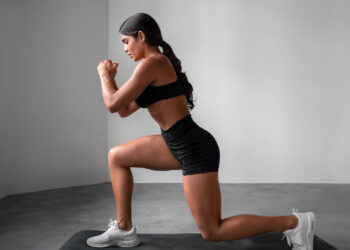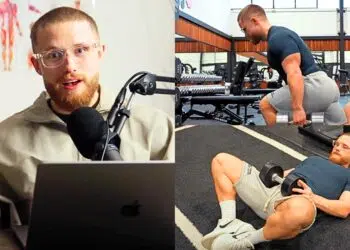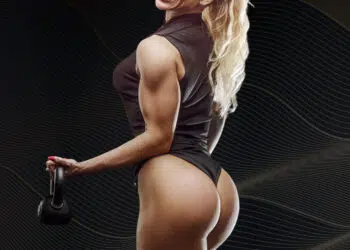Look around your gym, and you’ll probably see most women working on their glutes. Besides improving your aesthetics, training your butt can help improve your posture, balance, strength, and explosive power. The glutes are, after all, the biggest and strongest muscle in your body.
Glutes come in several shapes and sizes. However, the heart-shaped butt is arguably the most popular derriere silhouette. Other than its divine aesthetics, the heart-shaped butt represents fertility, which is one of the reasons why they are popular amongst men.
Most lower-body workouts you see on social media are focused on helping you build a pear-shaped butt.
What is a Heart-Shaped Butt?
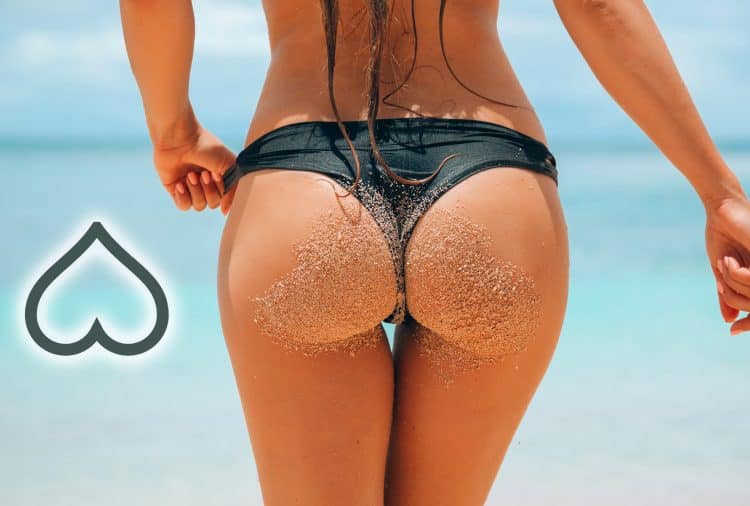
A heart or inverted-pear-shaped rear is characterized by a tapered waistline and fat distributed in the lower part of your butt or thighs. When looked at from behind, the shape of your hips and tapering waistline gives the illusion of an inverted heart or A-shape.
What are the Other Butt Types?
Knowing your butt type can help you better structure your workouts or at least choose the right type of jeans or underwear for yourself. There are four main butt categories based on ratios between your waist, hips, and thighs. These are:
- Heart-Shaped Butt: Also known as A-shaped or pear-shaped butt, it represents a tapered waistline and fat distributed in the lower part of your butt or thighs.
- Square Butt: If the shape from your hip bone to your outer thigh is more or less a straight line, you have a square or H-shaped butt.
- Inverted Butt: Involves more fullness at the top, near your waistline, and less volume in the lower butt cheeks.
- Round Butt: The full hips and fat distribution around the butt cheeks create a curvy, rounded butt look from behind. It is also known as a bubble or O-shaped butt.
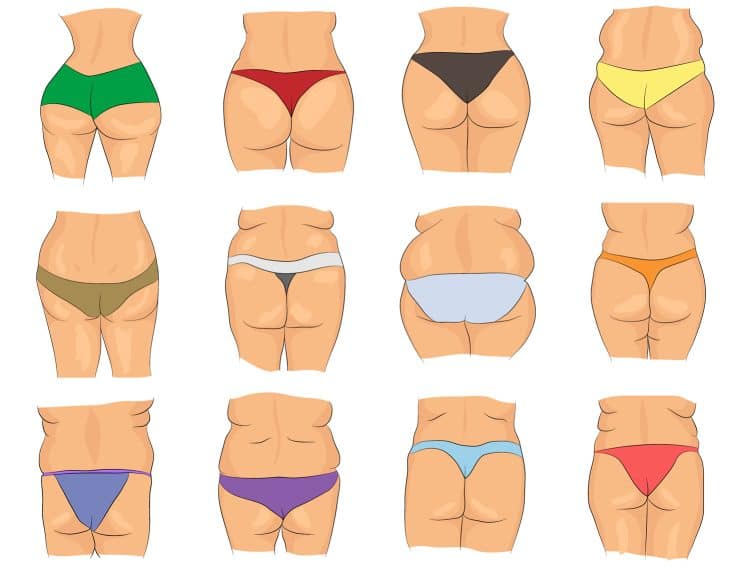
Related: Best Butts on the Internet.
Level Up Your Fitness: Join our 💪 strong community in Fitness Volt Newsletter. Get daily inspiration, expert-backed workouts, nutrition tips, the latest in strength sports, and the support you need to reach your goals. Subscribe for free!
Gluteal Anatomy
Learning about the muscular structure of your derriere can help you put together better workouts or choose and modify exercises for optimal glute engagement. Your glutes are made up of three main muscles:
- Gluteus Maximus: The maximus is the biggest glute muscle. Being the most superficial glute muscle, it is mainly responsible for shaping your rear.
- Gluteus Medius: The posterior third of the muscle is covered by the gluteus maximus. It primarily helps with hip abduction, external rotation, and maintaining frontal plane stability of the pelvis.
- Gluteus Minimus: It is the smallest of the three gluteal muscles. It helps with hip abduction and external rotation.
Heart-Shaped Butt Factors
The shape of your butt depends on the following factors:
1. Genetics
Genetics plays a vital role in determining your body structure. Your genetics dictate where and how much body fat you’ll store. Your muscle origin, insertion, shape, and fullness depend on your genetics.
Women predisposed to have a heart-shaped butt will store fat in the lower part of their glutes and upper thighs. They’ll also hardly store any fat in the abdominal region, giving them a favorable waste-to-hip ratio.
2. Bone Structure
Your hip shape will depend on your pelvic bone shape and how you carry fat and muscle. Women born with a narrow pelvic bone will have narrow hips, while those with a wide pelvis will have naturally wide hips, which are better suited for a heart-shaped butt.
3. Body Fat
Girls that store body fat in the lower part of their hips and thighs will have a relatively easier time building a heart-shaped butt. However, body fat should be kept under control as gaining too much weight can throw your hip-to-waist ratio off track.
4. Muscle
Some people have naturally muscular glutes. Your genetics will dictate the shape, size, roundness, and firmness of your rear. Women with heart-shaped butts generally find it easier to build muscle mass in their tush.
Related: How To Turn Your Square Butt Into a Bubble Bum
Nutrition Plan to Build a Heart-Shaped Butt
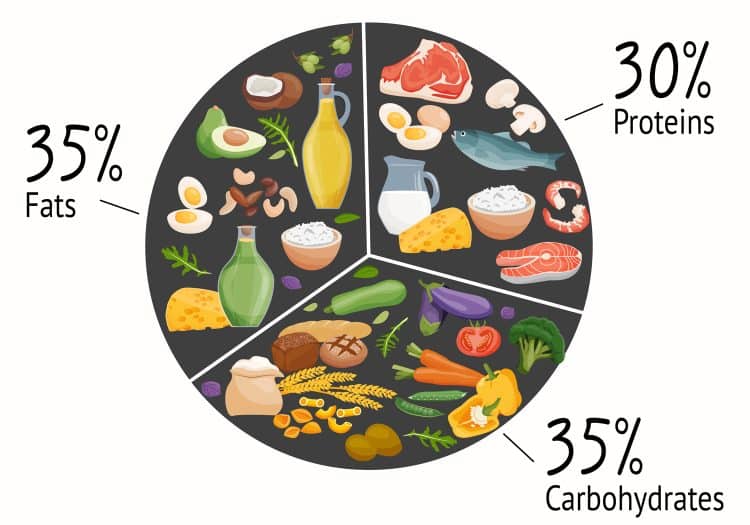
You must ensure you follow a balanced nutrition program to build a peach-shaped butt. The calories you consume will depend on your current body weight.
If you want to add size — which will be the case for most women — you’ll need to maintain a calorie surplus, meaning you’ll have to eat more calories than you expend in a day. You could use our convenient online calorie calculator to establish your daily calorie goal.
After you’ve determined your daily calorie goal, you need to break it down into a suitable macronutrient split focused on building muscle mass and shedding body fat. The three macronutrients and their oversimplified roles include:
- Protein: helps build and repair muscle
- Carbs: gives you energy
- Fats: keeps you satiated
Related: Macronutrient Calculator: Count Your Macros Easily
Sample Diet For a Heart-Shaped Butt
Given below is a sample 2,000-calorie diet plan that can help you build the buns of your dreams:
- Pre-workout: Almond butter and jam
- Breakfast: Oats with flaxseed powder, eggs, and berries
- Post Breakfast Snacks: Nuts, fruits like apples
- Lunch: Chicken or fish with plenty of salad and vegetables like spinach, beets, asparagus, broccoli, or romaine
- Post Lunch Snacks: Fruits or vegetables or a handful of almonds and berries
- Dinner: Edamame or snap peas with rice or steamed veggies and fish
Best Exercises for a Heart-Shaped Butt
Choosing the right exercises can be the difference between a great and an average butt. To build a round, strong, and muscular rear, you need to train your glutes from all angles.
Gluteus Maximus
The gluteus maximus is the biggest and strongest gluteal muscle. Most staple lower body compound movements target the maximus.
1. Barbell Back Squat
The barbell squat is one of the most popular leg exercises, and for good reason. Add it to your training regimen to build a strong, round, and thick butt.
How to perform:
- Stand upright with a shoulder-width stance.
- Position a barbell across your shoulder on your back.
- While keeping an upright torso, bend your knees and lower into a squat until your quads are at least parallel to the floor.
- Push through your heels to return to the starting position.
- Do not lock your knees out when you stand up.
- Repeat for recommended reps.
Benefits:
- A complete leg-builder that’ll help build lower body strength and muscle mass.
- Helps build core strength.
Tips:
- Make sure you’re not bending forward or rounding your back while performing this exercise.
- Go as deep as possible for optimal glute engagement.
- Place a weight plate under your heels to improve your mobility and achieve better depth.
In This Exercise:
- Target Muscle Group: Quads
- Secondary Muscles: Calves, glutes, hamstrings, and lower back
- Type: Hypertrophy, strength
- Mechanics: Compound
- Equipment: Barbell
- Difficulty: Beginner
- Best Rep Range:
- Hypertrophy: 8-12
- Strength: 1-5
Check out our complete guide on barbell squat!
2. Barbell Hip Thrust
The barbell hip thrust is one of the best exercises to build bigger and stronger glutes. It is an isolation exercise that will leave you with a muscle-ripping pump.
Level Up Your Fitness: Join our 💪 strong community in Fitness Volt Newsletter. Get daily inspiration, expert-backed workouts, nutrition tips, the latest in strength sports, and the support you need to reach your goals. Subscribe for free!
How to perform:
- Sit with your back placed against the side of a bench.
- Roll a barbell up to your hip crease.
- Place your feet flat on the floor so your lower legs are perpendicular to the floor.
- Drive both feet into the floor and squeeze your glutes to lift your hips towards the ceiling.
- Pause and contract your glutes at the top.
- Lower your hips back to the starting position.
- Repeat for the desired number of repetitions.
Benefits:
- One of the best glute isolation exercises.
- Allows you to train your glutes without letting your hams or quads take over.
Tips:
- Use lighter weights and focus on contracting your glutes with every rep.
- Do not arch or round your back while performing the exercise.
- Your body should be in a straight line from head to knees at the top.
In This Exercise:
- Target Muscle Group: Glutes
- Secondary Muscles: Hamstrings and abs
- Type: Hypertrophy
- Mechanics: Isolation
- Equipment: Barbell
- Difficulty: Beginner
- Best Rep Range:
- Hypertrophy: 8-12
- Strength: 1-5
Check out our complete guide on barbell hip thrust!
3. Stiff-Leg Deadlift
Since you maintain a slight bend in your knees in this exercise, it is the best deadlift variation to train your glutes. Focus on pushing your hips back in eccentric motion for better glute stimulation.
How to perform:
- Stand upright with a shoulder-wide stance.
- Place a barbell against your shins.
- Push your hips back and hinge forward until your torso is nearly parallel to the floor.
- Reach down and grasp the bar using a shoulder width, double overhand, or mixed grip.
- While maintaining a neutral spine, drive through the whole foot and focus on pushing the floor away as you return to the starting position.
- Pause and contract your glutes at the top.
- Repeat for recommended reps.
Benefits:
- Helps build explosive power.
- A better range of movement for optimal glute stimulation compared to the other deadlift variations.
Tips:
- Slow down the eccentric motion for better glute recruitment.
- Rest the bar on the floor with every rep.
- Push your hips as far back as possible for the best glute engagement.
In This Exercise:
- Target Muscle Group: Hamstrings and glutes
- Secondary Muscles: Abs, adductors, calves, lats, lower back, quads, traps, and upper back
- Type: Hypertrophy
- Mechanics: Compound
- Equipment: Barbell
- Difficulty: Beginner
- Best Rep Range:
- Hypertrophy: 8-12
- Strength: 1-5
Check out our complete guide on stiff-leg deadlift!
4. Glute Bridge
The glute bridge is a variation of the barbell hip thrust and can be done using a barbell, dumbbell, kettlebell, or body weight.
How to perform:
- Start in a supine position on the floor with your arms at a 45-degree angle relative to your torso.
- Drive your heels into the floor and bridge your hips by squeezing your glutes.
- Slowly lower your hips to the starting position.
- Repeat for recommended repetitions.
Benefits:
- Since this exercise is performed while lying on the floor, it provides a stable base, which can help lift heavier with more confidence.
- Does not overload your lower back.
Tips:
- Place an elevated platform like an aerobic step under your feet for a better range of motion.
- Placing your feet together helps focus on the outer glutes.
In This Exercise:
- Target Muscle Group: Glutes
- Secondary Muscles: Abs and hamstrings
- Type: Hypertrophy
- Mechanics: Isolation
- Equipment: Bodyweight
- Difficulty: Beginner
- Best Rep Range:
- Hypertrophy: 8-12
- Strength: 1-5
Check out our complete guide on glute bridge!
Gluteus Medius
A toned gluteus medius can make your heart-shaped butt pop and help you carve an hourglass figure. Focus on this muscle group with the following exercises:
5. Lateral Band Walk
The lateral bank walk can help build stronger and bigger glutes. It can also be used as a warm-up or cool-down exercise on a lower-body training day.
How to perform:
- Stand upright with a shoulder-width stance.
- Wrap a band around your legs just above your knees.
- Get into an athletic position with your knees bent, hips flexed, and your eyes looking straight ahead.
- Step laterally towards your right.
- Repeat for the desired number of repetitions on one side before switching sides.
Benefits:
- A great exercise if you’re not a fan of lifting weights.
- Eliminates your upper body from the exercise.
- Minimal risk of injury.
Tips:
- Experienced trainers can tie an additional resistance band around their ankles for greater resistance.
- Take as big strides as possible.
- Your upper body should be slightly tilted forward for better glute activation.
In This Exercise:
- Target Muscle Group: Glutes
- Secondary Muscles: Abs and hamstrings
- Type: Hypertrophy
- Mechanics: Isolation
- Equipment: Bodyweight
- Difficulty: Beginner
- Best Rep Range: 8-12
6. Clamshell
The clamshell is a great glute isolation exercise to target the gluteus medius. You could make this exercise harder by placing a weight plate or dumbbell on your top leg.
How to perform:
- Lie on your side on the floor with your knees bent and your bottom arm under your head for support.
- While keeping the heels together, raise the top knee as high as possible by activating the glute.
- Pause and contract your glutes at the top.
- Slowly lower back to the starting position.
- Repeat for the desired number of repetitions before switching sides.
Benefits:
- One of the best bodyweight glute isolation exercises.
- A unilateral exercise that helps focus on one side at a time.
Tips:
- Keep your torso straight throughout the movement. Arching your back will put unnecessary tension on your lower back.
- Use a resistance band, weight plate, dumbbell, or kettlebell for added resistance.
- Slow the eccentric motion for better glute stimulation.
In This Exercise:
- Target Muscle Group: Glutes
- Secondary Muscles: Abs and hamstrings
- Type: Hypertrophy
- Mechanics: Isolation
- Equipment: Bodyweight
- Difficulty: Beginner
- Best Rep Range: 8-12
7. Hip Abduction Machine
The hip abduction machine is one of the best training equipment to train the gluteus medius.
How to perform:
- Sit on the machine with your back against the pad and your spine neutral.
- Place your knees on the inside of the pads.
- Exhale and push your legs apart as far as possible.
- Pause and contract at the top.
- Slowly return to the starting position.
- Repeat for recommended repetitions.
Benefits:
- The cables help maintain constant tension on your glutes throughout the motion.
- It prevents the gluteus maximus from taking over.
Tips:
- Sit upright for a better range of motion.
- Drive through your knees for better glute stimulation.
In This Exercise:
- Target Muscle Group: Abductors
- Secondary Muscles: Glutes and hamstrings
- Type: Strength
- Mechanics: Isolation
- Equipment: Machine
- Difficulty: Beginner
- Best Rep Range: 8-12
Check out our complete guide on hip abduction machine!
8. Fire Hydrant
The fire hydrant is one exercise that looks super easy but leaves you sore the next day.
How to perform:
- Get into a tabletop position with your hands under your shoulders and your knees under your hips.
- While keeping your left knee bent, lift your left leg to your side as high as possible.
- Pause and contract your glute at the top.
- Repeat for recommended reps before switching sides.
Benefits:
- Improves your core strength and abs while focusing on your glutes.
- Improves hip extension, external rotation, and abduction.
Tips:
- Keep your torso straight and your head neutral throughout the exercise.
- Tie a resistance band around your lower back and knees to keep constant tension on your glutes.
In This Exercise:
- Target Muscle Group: Glutes
- Secondary Muscles: Hip flexors
- Type: Strength
- Mechanics: Compound
- Equipment: Bodyweight
- Difficulty: Beginner
- Best Rep Range: 8-12
Check out our complete guide on fire hydrant!
Gluteus Minimus
Even though it is impossible to isolate a single glute muscle, performing exercises that target a particular region of the butt can help create a 3D effect.
9. Bulgarian Split Squat
The Bulgarian split squat is an advanced exercise. If you are a beginner, you should start with the conventional split squat before adding this movement to your training regimen.
How to perform:
- Stand with your back towards the side of a flat bench.
- Grab a dumbbell in each hand.
- Position your left foot on the bench behind you.
- After finding balance, descend by flexing the right knee and continue until the back knee is a few inches away from the floor.
- Drive through the right foot and extend the knee to return to the starting position.
- Repeat for recommended reps before switching sides.
Benefits:
- Besides a pair of muscular legs, the Bulgarian split squat helps build balance, stability, and a strong core.
- Helps correct muscle and strength imbalances.
Tips:
- You could make this exercise harder by using a stability ball instead of a flat bench.
- Focus on your glutes in this exercise by taking a slightly larger split stance.
In This Exercise:
- Target Muscle Group: Quads
- Secondary Muscles: Abs, adductors, calves, glutes, hamstrings, shoulders, traps, and upper back
- Type: Strength
- Mechanics: Compound
- Equipment: Dumbbell
- Difficulty: Beginner
- Best Rep Range: 8-12
Check out our complete guide on Bulgarian split squat!
10. Cable Pull-Through
The cable pull-through is a great exercise for the glutes and hamstrings as it keeps constant tension on the target muscles by eliminating inertia.
How to perform:
- Attach a rope handle to a pulley and set it at the lowest setting.
- With your back towards the cable pulley, grab the rope handle with a neutral grip and take a few steps away from the machine.
- Assume a wider-than-shoulder-width stance and bend your knees slightly.
- Begin the movement by bending at the waist and pushing your hips back towards the machine.
- Pause for a second at the bottom.
- Explode to the starting position.
- Pause and contract your glutes at the top.
- Repeat for recommended reps.
Benefits:
- Will help achieve a muscle-ripping pump.
- Makes you proficient at the hip hinge movement.
- Helps strengthen your lower back.
Tips:
- Maintain a neutral spine throughout the movement.
- Push your hips as far back as possible to achieve optimal glute and hamstring stimulation.
In This Exercise:
- Target Muscle Group: Hamstrings and glutes
- Secondary Muscles: Quads, calves, hamstrings, and lower back
- Type: Strength
- Mechanics: Compound
- Equipment: Cable
- Difficulty: Beginner
- Best Rep Range: 8-12
Check out our complete guide on cable pull-through!
Workout Plan for Heart-Shaped Butt
The two heart-shaped butt-building workout programs will target your glutes from all angles, ensuring overall development.
Workout 1
- Squat: 3 x 8-12
- Bulgarian Split Squat: 3 x 8-12
- Barbell Hip Thrust: 3 x 8-12
- Hip Abduction Machine: 3 x 8-12
- Leg Press: 3 x 8-12
- Glute bridge: 3 x 8-12
Workout 2
- Lateral Band Walk: 3 x 8-12
- Squat: 3 x 8-12
- Stiff-Leg Deadlift: 3 x 8-12
- Clamshell: 3 x 8-12
- Fire Hydrant: 3 x 8-12
- Cable Pull-Through: 3 x 8-12
Frequently Asked Questions
How long does it take to get a heart-shaped butt?
It could take 3-4 weeks on a balanced training and nutrition diet before the needle starts budging in the right direction. Maintaining a heart-shaped butt requires a lifestyle shift.
Can I get a heart-shaped butt without exercise?
Yes. You could be genetically predisposed to a heart-shaped butt if your pelvic bone is wider at the bottom and tapers towards the top. However, if you have one of the other three types of butts, you’ll need to train to build a pear-shaped rear.
Which is the best butt shape?
You should be happy and confident with your body, no matter the shape of your butt. Heart-shaped, square, inverted, or round butts are all personal preferences.
Wrapping Up
A toned and muscular booty is aesthetically appealing and can improve your athletic performance and help prevent injuries. Some people are genetically inclined to have a heart-shaped butt, while others have to work hard for it.
This article has everything you need to know — diet, exercises, workouts program — to build and maintain a peachy butt. Remember: Building a shapely butt can take some time, so be patient, and the results will follow. Best of luck!





